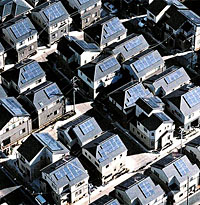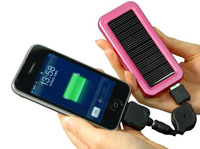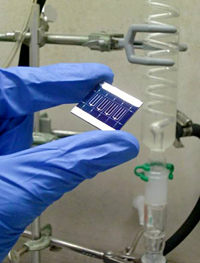How Solar Panels Work: A Comprehensive Guide
Solar panels have become a cornerstone of renewable energy solutions, providing a sustainable means of generating electricity by harnessing the power of the sun. This comprehensive guide delves into the science behind solar panels, focusing on photovoltaic (PV) cells and the process of converting sunlight into electricity.
The Basics of Solar Panels
[ad] Empty ad slot (#1)!
Solar panels, also known as photovoltaic (PV) panels, are composed of numerous solar cells that capture sunlight and convert it into electrical energy. Each panel typically consists of multiple solar cells connected in series or parallel to form a module, which can then be installed on rooftops, solar farms, or other suitable locations.
Photovoltaic Cells: The Heart of Solar Panels
Photovoltaic cells are the fundamental building blocks of solar panels. These cells are typically made from semiconductor materials, most commonly silicon, which exhibit unique properties that enable the conversion of light into electricity.
1. Structure of a Photovoltaic Cell:
A typical photovoltaic cell consists of two layers of semiconductor material:
- P-type (positive-type) semiconductor: This layer is doped with elements such as boron, which create spaces known as “holes” where electrons can move.
- N-type (negative-type) semiconductor: This layer is doped with elements like phosphorus, which provide extra electrons.
2. The P-N Junction:
The interface where the P-type and N-type layers meet is called the P-N junction. This junction creates an electric field that is crucial for the operation of the solar cell. When these two layers are brought into contact, electrons from the N-type layer fill holes in the P-type layer near the junction, creating a depletion zone with an electric field.
The Photovoltaic Effect
The photovoltaic effect is the process by which sunlight is converted into electrical energy in a solar cell. This effect can be broken down into several key steps:
1. Absorption of Sunlight:
When sunlight strikes the surface of a photovoltaic cell, it is absorbed by the semiconductor material. The energy from the sunlight excites electrons in the semiconductor, causing them to break free from their atomic bonds.
2. Generation of Electron-Hole Pairs:
The absorbed sunlight provides enough energy to excite electrons to a higher energy state, creating electron-hole pairs. An electron-hole pair consists of a free electron and the corresponding hole it leaves behind.
3. Separation of Charge Carriers:
The electric field at the P-N junction drives the free electrons towards the N-type layer and the holes towards the P-type layer. This separation of charge carriers generates a flow of electrons, creating an electric current.
4. Collection of Electrical Current:
Metallic contacts on the top and bottom of the photovoltaic cell collect the free electrons. These contacts are connected to an external circuit, allowing the electrons to flow through the circuit and generate usable electrical power.
Conversion of DC to AC Power
The electricity generated by solar panels is direct current (DC), which needs to be converted to alternating current (AC) for use in homes and businesses. This conversion is accomplished using a device called an inverter.
1. Inverters:
Inverters transform the DC electricity produced by solar panels into AC electricity. There are different types of inverters, including string inverters, microinverters, and power optimizers, each with specific applications and efficiency levels.
Efficiency of Solar Panels
The efficiency of a solar panel refers to the percentage of sunlight that can be converted into usable electricity. Several factors influence the efficiency of solar panels:
1. Material Quality:
High-quality semiconductor materials, such as monocrystalline silicon, tend to have higher efficiencies compared to lower-quality materials like polycrystalline silicon.
2. Cell Design:
Advancements in cell design, such as Passivated Emitter and Rear Cell (PERC) technology, can enhance the efficiency of solar panels by reducing electron recombination and improving light absorption.
3. Environmental Conditions:
Temperature, shading, and the angle of sunlight incidence can affect the performance and efficiency of solar panels. Optimal installation and maintenance are crucial for maximizing efficiency.
Advances in Solar Panel Technology
Ongoing research and development are driving significant advancements in solar panel technology, leading to increased efficiency and reduced costs.
1. Perovskite Solar Cells:
Perovskite materials have emerged as a promising alternative to silicon, offering high efficiency and low production costs. These cells are still in the experimental stage but show great potential for future applications.
2. Bifacial Solar Panels:
Bifacial solar panels can capture sunlight from both sides, increasing overall energy production. These panels are particularly effective in environments with high albedo, such as snowy or sandy regions.
3. Transparent Solar Cells:
Transparent solar cells can be integrated into windows and building facades, allowing for electricity generation without compromising aesthetics. This technology opens up new possibilities for urban energy solutions.
Looking Ahead
The science behind solar panels is a testament to the incredible potential of harnessing renewable energy. As technology continues to advance, the efficiency and affordability of solar panels are expected to improve, making solar power an increasingly integral part of our energy landscape. Understanding how solar panels work provides valuable insight into the innovations driving this renewable energy revolution.
[ad] Empty ad slot (#1)!
 Usage of Solar Energy
Usage of Solar Energy Solar Plants
Solar Plants Solar panels for homes
Solar panels for homes Portable Solar Charger
Portable Solar Charger Mini Solar Cell
Mini Solar Cell